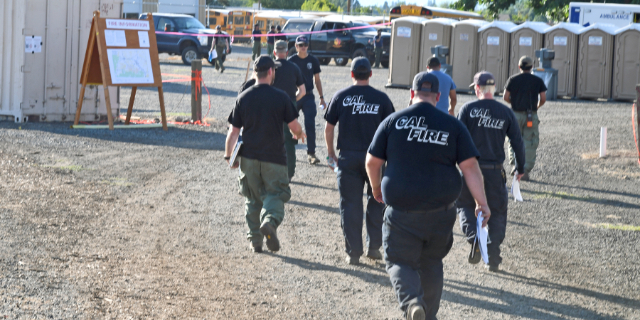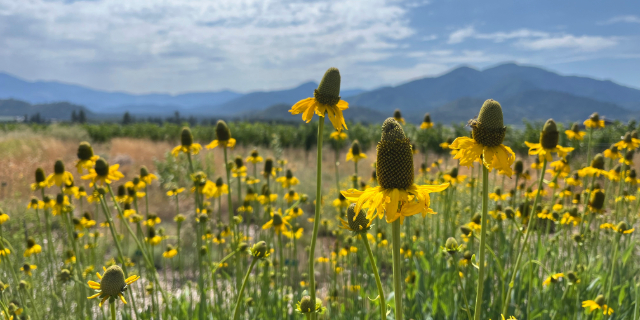Siskiyou Rappellers fight fire where others can’t
Published 11:15 am Wednesday, June 28, 2023

- A rappeller descends from a firefighting helicopter at the Siskiyou Rappel Base.
Back at their helibase on Flaming Road near the Grants Pass airport last week, the Siskiyou Rappellers crew enjoyed a rare stretch of home cooking.
Trending
The 23-man crew rappels from a type-2 Bell 205 helicopter into terrain too remote for heavy equipment. A national resource for the U.S. Forest Service, they have already spent 25 days fighting fires in North Carolina this year, said Tanner Ormond, an 11-year veteran of the crew who is now a manager and “spotter.”
The spotter stays with the helicopter, he said, because it’s his responsibility to plan the assignment from the moment a call comes in from dispatch to the moment when all his crew members have their boots safely on the ground. As fires grow in complexity and frequency around the country, more often than not their boots are hiking somewhere far from home.
“What is a typical season, it varies. In region, out of region. In state, out of state. On the forest all summer, off the forest all summer. It’s just anybody’s guess,” said Charlie Fabris, also a manager and spotter.
Trending
“The forest” is the Rogue River-Siskiyou National Forest, their primary protective area. There are only 12 rappeller crews in the country, and only three are fully staffed this year, Ormond said. The demand for this unique resource often requires long sojourns from home. Last year, the crew endured its longest assignment in memory — 96 days in Dunsmuir, California. In 2018, the crew was called as far away as Georgia and Tennessee.
It’s common for the firefighters to spend more time with their crew than with their families.
“My wife is a very understanding woman, and my kids miss me very much. She actually marks off the days that I’m gone on a calendar at home. I think I’m at 54 this year,” Ormond said.
Rookies joining the crew must be experienced firefighters and certified sawyers. But there is also something intangible, Ormand said — a combination of tenacity and a cool-headed capacity for problem-solving. It’s something he said he can’t completely describe, but “I know it when I see it.”
Six rookies signed on this year and completed their training June 10.
Walking around their base — the Siskiyou Rappel Base at the Merlin Fire Center — Ormond spoke in a soft, quiet voice as he explained the demands of the work.
During the season, firefighters cannot leave the base during the day. If a call from dispatch comes in, their response is expected to be swift.
“When I receive a phone call or an email that we have a fire to go to, we try to be off the ground in 10 minutes,” he said.
Every morning, the crew reports to an expansive building on base where gear is stored. They gather around a door with name tags grouped under headings to designate the four firefighters on the “load,” or flight manifest, that day.
After roll call, the spotter leads his team through a morning briefing — weather regionally and nationally, the number of rappel crews nationally available, a safety briefing and safety checks on the helicopter.
After the briefing, an hour and a half of PT — personal training — is mandatory to keep them in shape for their work, Ormond said. Then there are always chores around the base, tools to sharpen, equipment to clean.
Along one wall in the hanger-like space, tall rectangular boxes are taped together. Inside, hand tools are visible, including a Pulaski. These “IA” — initial attack — boxes are packed at the beginning of the season, Ormond said. After the men rappel to the ground, the spotter sends these boxes down the ropes to the crew. Each box weighs around 100 pounds. The trees of the Pacific Northwest necessitate full-size chainsaws, and these also come down the ropes in boxes.
Tall cubby spaces along one wall hold flight helmets and Nomex — heat- and flame-resistant gear. On the bottom shelf are round red bags, hardly larger than a house cat and limited to 30 pounds. Crew members can bring only what they can fit, unless they use a flight suit with pockets.
The bags are packed with tools, a fire shelter, hard hat, food, sleeping bags and possibly some luxuries such as a bug screen for the swarms of mosquitoes they often encounter — or a jacket, as fire season drifts into the fall and winter months. Asked how long it took to learn how to pack such a small bag for remote wilderness missions, Fabris smiled.
“It took years,” he said.
After a day’s work, the crew hikes out to sleep close but not too close to the fire. The same terrain that necessitates rappelling from a helicopter means the best sleeping spot is usually “flat-ish,” Fabris said.
“Sometimes it just comes down to digging into that hillside to make a place where you can kind of tuck in,” he said.
Along a wall in the hangar-like building, shelves from floor to ceiling are filled with food for the crew. Dehydrated potatoes, canned raviolis and Spam are quickly recognizable.
“There’s a lot you can make out of that, spambalaya,” Fabris said.
Tall and broad shouldered with thick brown hair, Fabris is a 12-year veteran of the crew. Walking into the office he and Ormond share, he pointed to a floor-to-ceiling map of “the forest” and nearby areas. Across from the map are two standing desks, each decorated with framed photos of children.
“When we get a call, we’ll usually turn around and look at where we’re going to go, how far away we’re going to be from the base. Because the helicopter only has a limited amount of fuel, we have to find the most efficient route. We give the pilot a lat and long,” Ormond said.
Both men alternate being the assigned spotter the way the crew members rotate through being on the load on any given day. Whoever is in charge when a call comes in has to locate the fire, plan the route, consider the weather and temperature. Extra fuel can be trucked to the fire site. High elevations and cooler temperatures make it easier for the bird to fly, he said.
Spotters are also responsible for arranging the other resources for the mission, such as the technicians who service the helicopter, a trailer with extra supplies, and a fleet of Forest Service vehicles. For long missions, the spotter can arrange for these resources to follow the helicopter.
Before they climb into the helicopter — and again before they rappel from it — multiple safety checks are performed exactly the same way every time, Ormond said.
Crew members stand opposite each other outside the aircraft, checking to make sure their belly bags, harnesses and metal rappel mechanisms are properly attached. Once they climb aboard the helicopter, they buckle into elastic ropes on the seats.
The four large men sit with their knees and shoulders touching in the cramped interior, their eyes invisible under the visors of their flight helmets. Sitting opposite the crew is the spotter, connected to an elastic belt with enough lead to walk over to the edges of the aircraft to help the crew members and gear go safely down the lines.
The spotter has to learn a series of hand signals to communicate with the crew as they prepare to rappel down. While the helicopter is hovering 300 feet above the ground with its blades whirring, it’s impossible to hear anything, Ormond said. Once the crew locates the fire, the spotter communicates with dispatch by radio.
“We give a size-up of the fire and ask if they want us to staff it,” Ormond said.
Sometimes, the crew merely offers reconnaissance, using their bird’s-eye view to guide ground crews along the best route to the fire. Sometimes the helicopter delivers a bucket drop. Usually it’s done with a Bambi Bucket — a collapsible, red, 240- to 300-gallon bucket stored in the cargo hold, then attached to the bottom of the bird with a rope.
“There’s a valve at the bottom. They actually go in there, set the bucket on the water, it has a weight on one side of the bucket that causes it to tip over and sink. Once they see the bucket submerge, then they fly over the fire,” Fabris said.
If dispatch gives the crew the order to staff the fire, the doors of the helicopter open. The spotter points at a firefighter on each side of the aircraft. He runs his hand along a rope from the row of seats along the ceiling to the door on either side. Then with a nod and hand signals, he communicates to detach from their seat belts, attach to the rope, and come forward. From the ground, a yellow rope unfurls from the door of the helicopter.
For a moment, the men are not visible. There’s nothing but the sound and the wind of the helicopter. The spotter is still checking the rope, harness, and for a sound connection between the two. After a few seconds, boots and legs appear. The firefighter holds the rope with his feet on the skids, facing the spotter. When he is given the signal, he slides gracefully down the rope to the ground.
After the mission is over, the men have to hike back to civilization with everything they brought with them. Between IA boxes, chainsaws, and their personal bags, the total weight is 100 pounds or more. There are very few places for a helicopter to land where the skills of the Siskiyou Rappellers are needed.
“Sometimes it’s a half a mile or a quarter-mile where you can get up to a road. I think the longest was the Willamette — it was 10 or 12 miles,” Fabris said.
Despite the relative risk of the work and its remote location, the crew is not required to have certified EMTs. The Siskiyou Rappellers are lucky to have four, Ormond said. But crew members pursued those qualifications on their own dime and time.
“We all are certified in CPR and first aid,” he said.
For all the sacrifice, the sweat, risk and arduous work, the Rappellers are devoted to the work because of what they find in it.
“There’s always a challenge for you to figure out. Whether you’ve just started and you’re trying to figure out how to rappel or you’re the spotter and you’re trying to figure out how to safely put people into the fire, there’s always some sort of challenge you’re able to test yourself with to improve your mind or improve yourself,” Ormond said. “It’s fairly rewarding to move up and experience all the different challenges. … Flying around is also very enjoyable.”
For more information, see www.siskiyourappellers.com/









